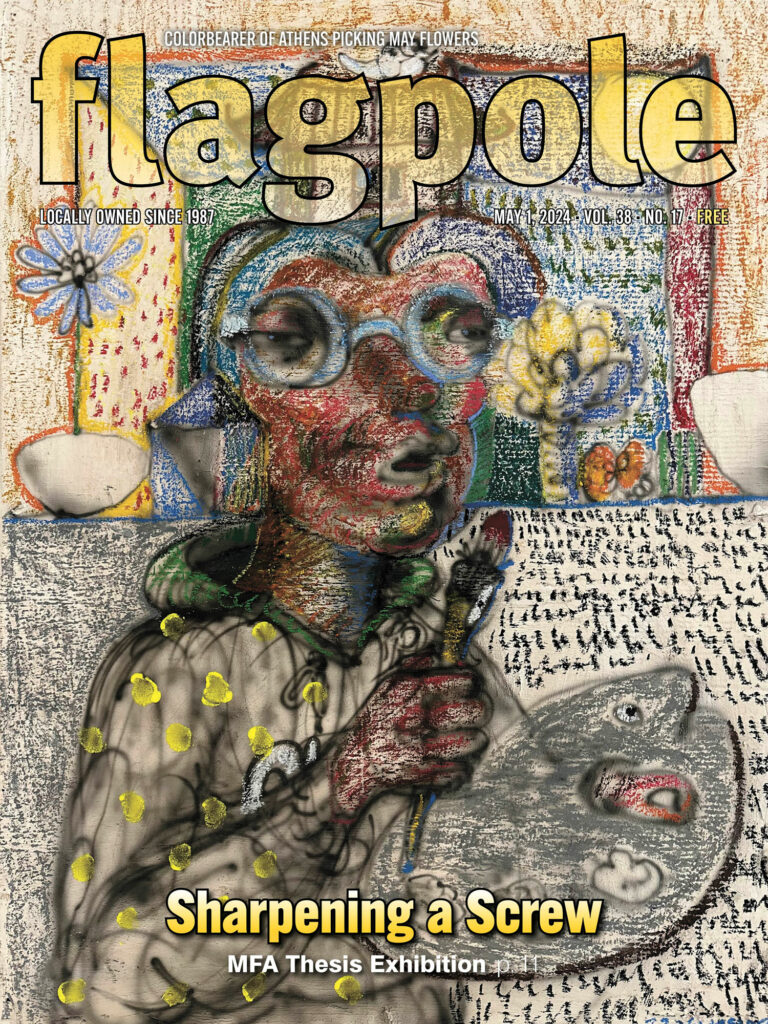A decades-long tradition of UGA’s Lamar Dodd School of Art, the annual Master of Fine Arts degree candidates exhibition offers a time capsule of new artworks that are reflective, thought-provoking and occasionally perplexing.
Through a partnership dating back to the 1950s, the exhibition was previously held at the Georgia Museum of Art every year—a celebratory occasion symbolizing the culmination of each candidate’s academy studies as they complete a terminal degree and transition into the professional art world. The exhibition has now been hosted at The Athenaeum, UGA’s new contemporary art gallery located downtown, since its founding in 2021.
This year’s exhibition title, “Sharpening a Screw,” references the compulsion that often drives a creative practice, a yearning not only for self-discovery, but an urgency to make meaning of the surrounding world. All of the nine graduating artists present distinct bodies of work that utilize unique materials as conduits for larger ideas.
The most prevalent theme appearing throughout the thesis show relates to mankind’s relationship to the natural environment and a recommitment to more sustainable practices. Accompanied by a short film and handmade artist book of gelatin prints, Dylan Lewis’ body of work, “Pearl,” consists of a sizable collection of handmade clothing. These painstakingly made garments are created in a dreary seaside color palette of mud, sand, storm clouds and night sky using natural dye processes. These muted colors offer a sense of anonymity and self-obliteration as the wearer dissolves into the landscapes that inspired them. Lewis’ practice contemplates fabric’s capacity to contain memory and how the physical process of garment-making can serve as an act of devotion.
Katherine Rutter’s wall-spanning installation, “Now if Not Before,” suggests a deep reverence for the natural world and tenderness towards the complexity of the human experience. Inspired by her time spent at the Ogeechee River, this delicate work depicts a fantastical illustration of creatures crossing tannin-rich dark waters, surrounded by a frenzy of biomorphic paper forms. Essentially working in collaboration with nature, she creates inks from goldenrod, walnut, oak gall, mica, corn husk, river water, turmeric, coffee, abaca, flax and all sorts of other plants and soils.

The photographic practice of Lindsey Kennedy centers around the human-nature relationship, primarily investigating the individual psychological experience of navigating climate change. Her thesis piece, “A Chaos of Hard Decay,” offers a collection of images selected from various explorations into wetlands, caves, topiary gardens, a burning forest and other unique ecosystems. Collectively, these images acknowledge how the planet contains multitudes.
Meredith Emery’s work, “the objective line of a wandering thought,” was inspired by the American burying beetle, an endangered insect that, true to its name, buries the carcasses of small vertebrates for its larvae. A black and reddish-orange table resembles the insect with its arched legs and slim oval design. On top of the table is a long, thin scroll of paper with a story inscribed; a crank and microscope are intended to help the viewer access a tale of natural history.
Artists Ashley Wingo and Katie Ford both repurpose objects for alchemical results. Wingo’s mixed media assemblage, “Xanadu’s Mountain,” is a hodgepodge of miniature objects exploring memory, nostalgia and obsolescence. Rings, necklaces and brooches incorporate discarded materials like carpet foam, balloons and found photos, while faded pastels juxtapose with more vibrant iridescent colors to blur the past and present.
Ford’s mixed-media sculptures use abstraction to explore intangible aspects of form and space. Materials such as a lawn chair, insulation foam, found plastics and pigment prints of silk are assembled together to create an interconnected object whose parts remain just as great as their sum. Ford’s sculptures challenge the perceived notion of containment and the ability of a body to be more than one thing.
The interdisciplinary works of Alejandro Ramirez are a refreshing burst of absurdity, repurposing thrifted relics into interactive, new technologies. “Archive Special Programming” uses Arduino Uno to display a stream of humorous one liners and nonsensical head-scratching phrases, offering a glimpse into the artist’s own personality. A very creative way to pitch an album, “The Best of Brother Chacho” consists of an Adafruit Sound Board embedded into a briefcase, with each push button activating a different recording.
Martin Chamberlain’s work, “Hubris,” similarly undermines the intended purpose of an ordinary object to create an art object instead. Taking the pedestal as his focal point—a fundamental object within any gallery space that visually establishes what the art is—Chamberlain adds rounded bottoms that prevent the pedestals from performing their function. Built with internal robotics, the pedestals fall flat and shimmy right side up, just to wobble and fall again.
Of the works presented in “Sharpening a Screw,” those of Yoon Hwang are perhaps the most rooted in tradition and grounded by a spiritual faith. In addition to several paintings, including “Cartoon Chau” on this week’s cover of Flagpole, Hwang fills an entire gallery room with his “Garden Spirits.” These earth-toned ceramic works range from large vessels to intricate pagoda-like structures accented with small animals sure to add harmony and intrigue within any landscape.
“Sharpening a Screw” will remain on view through Thursday, May 9. The Athenaeum is open Wednesdays through Saturdays from 12–6 p.m., and free parking is available directly behind the building at 287 W. Broad St.
Like what you just read? Support Flagpole by making a donation today. Every dollar you give helps fund our ongoing mission to provide Athens with quality, independent journalism.
